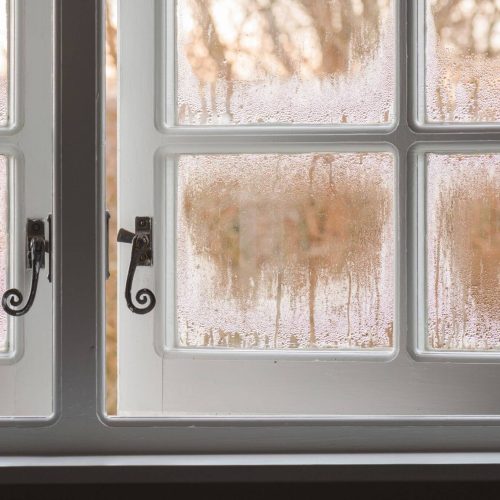Why Is There Condensation On My Windows?
Condensation on windows occurs when moisture in the air comes into contact with cooler window surfaces in your home. If your home has high humidity levels, you're more likely to see condensation on your windows. So, why does this happen?
What Is Condensation?
Condensation occurs when humid air comes in contact with water droplets collected on a colder surface.
The result of relatively warmer and humid air meeting a cold surface can lead to condensation forming on that surface. Their surfaces are colder than the walls with insulation against temperature variations. Condensation can appear on the interior, exterior, or between window panes, serving as an indicator of potential window issues depending on its location.
Ways Condensation Forms on Windows
Here are the three ways condensation can develop on your windows and how to address each one.
Condensation on the Inside of Windows
Replacing drafty windows and doors or upgrading your roof or siding can minimize air infiltration, improving your home’s overall seal. While this helps reduce energy costs, a tighter seal also retains more indoor humidity. This can lead to increased condensation on colder surfaces inside your home, especially after these improvements. Persistent indoor window condensation may promote mold and mildew growth, particularly on organic materials such as wood. Consider condensation on your windows as a warning sign to manage indoor humidity levels before more serious issues arise.
How To Reduce Condensation On The Inside of Windows
Circulate Interior Air: to prevent excess humidity buildup and potential condensation, consider leaving interior doors open, using ceiling fans, or even cracking open windows when weather conditions allow.
Solve Home Ventilation Issues: areas like your laundry room and around your fireplace can generate excess humidity, potentially leading to issues such as mildew or mold. Addressing these problem areas in your home will help reduce window condensation.
Use Dehumidifiers: using a dehumidifier to remove moisture from the air can effectively reduce window condensation, while also providing additional health and comfort benefits.
Run Exhaust Fans: your kitchen and bathroom may already have exhaust fans, they’re so effective in reducing the moisture released into the air while cooking and showering.
Condensation On The Outside of Windows
Exterior condensation typically occurs during summer months when outdoor humidity levels are high. It forms similarly to interior condensation, with window glass cooling and contacting warm, humid air. When the glass temperature falls below the dew point outdoors, you’ll notice condensation or dew on the exterior of your windows. This natural phenomenon happens when the air reaches maximum water saturation. Factors contributing to exterior window condensation include high outdoor humidity, calm conditions, and clear nights. Homeowners often observe this in the early morning after cool nights, with dew evaporating as the sun warms the glass throughout the day.
How To Reduce Condensation On The Outside of Windows
Trim Shrubbery Near Windows or Doors: trimming shrubbery near windows or doors promotes better air circulation, enabling sunlight to warm the window and hasten the evaporation of condensation. Similar to how dew evaporates from grass as outdoor temperatures rise, condensation on windows will also evaporate more quickly under warmer conditions.
Raise the Temperature Setting on Your Air Conditioner: Increasing the temperature setting on your air conditioner can raise the temperature of your window glass, reducing the likelihood of condensation. Think of it like sipping cold lemonade on a hot summer day: the glass gets wet when warm air meets its cool surface. By elevating the glass temperature, you can help prevent condensation from forming.
Condensation Between Your Window Panes
Condensation between your window panes, especially in double- or triple-paned windows, signals a significant problem. Typically, this indicates a seal failure, allowing moisture to infiltrate between the glass layers. While repairs may be an option, it’s often a sign that high-performing window replacements are necessary to address the issue effectively.
The answer lies in the difference in temperature between the indoor air and the window surface. Doors can also contribute to condensation issues if they're poorly sealed, allowing warm, humid air to enter your home and come into contact with cooler surfaces.
Having a window that has so much condensation indicates a need to learn why this occurs and what can be done to address it. Excessive moisture in the house can lead to condensation forming on windows and door, indicating that there is too much moisture indoors. Many homes experience this issue, but learning how to stop it is crucial. To combat condensation, make sure to follow measures such as improving ventilation, reducing indoor humidity levels, and ensuring proper insulation.
If you are looking for contractors for your upcoming general home renovation project at New America Construction we provide windows estimates for all NJ homeowners.
Call us for more information 973-804-9400
Find us in:


